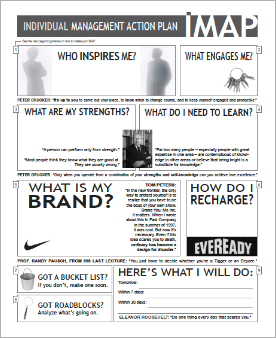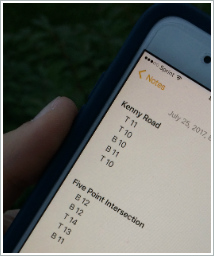You’ve come to the right place for buzzword-free info about work, workplaces, and workplace improvement. These posts are all about improving work processes, strengthening teamwork, sharpening management skills and leadership skills, improving communication, and more. This is info you can use right away, full of practical ideas in straight-talking plain English. Enjoy!
• Have a suggestion or question for a possible future post? Please let us know.
Here’s how a few index cards can strengthen your team

In case you’re wondering, the answer is no. You don’t need to be an expert facilitator or a miracle worker to bring out the strengths and tighten the bonds of your work group.
But you do need to try new things – and that’s what this quick group activity is all about.
It works great with any team numbering up to about 15 people. It uncovers everyone’s strengths in a constructive and co-creative way. Best of all, the benefits are powerful and long-lasting.
In terms of materials, all you need are small envelopes, index cards, and a pen or marker for each person.
Before the group meets, put one blank card in each envelope. When the group is together, give each person a quantity of envelopes/cards matching the total number of people in the team. (If the team numbers 10 people, give each person 10 envelopes, each containing a single index card.)
Now give these simple instructions to everyone:
• Write your name on the outside of each envelope in your stack. Leave the index card inside and untouched. (If there are 10 people in the group, you’ll write your name on all 10 of the envelopes.)
• Keep one of the envelopes (with your own name on it) for yourself, then circulate all the other envelopes to everyone in the room – so that each person gets one envelope from everyone else. (Back to our example group of 10 people: Each person would end up with a new stack of 10 envelopes, each addressed with the name of a different team member, including one envelope with their own name.)
• Now for the heart of the activity: Take one of the envelopes, noticing the name that’s written on it. Think positively about this co-worker. Reflect on some of your positive interactions with them – and some of the positive things you’ve seen in their interactions with others. Look for words that capture their positive qualities. Then take the index card, write down what you view as their greatest one or two strengths, put the index card back in the envelope, and seal it.
• Take a second envelope from your stack, with the name of another person written on it, and repeat the activity. Do this for all the envelopes/people, so that you’re thinking positive and documenting the strengths of everyone in the group.
• Take enough time for this, and avoid talking. The room should stay quiet while everyone reflects and writes.
• The work group manager or team leader should participate as an equal, following all the steps in this activity in the same way as everyone else.
• Recommended: Write more than two or three words on a card. Try to expand out, perhaps even writing the strength(s) in the form of a note to the person. Aim to be conversational. One way is to cite a strength and then write an example of when you saw that strength in action. (Example: “Your empathy always shines through. When that complaining customer came in last week, you really listened, you showed understanding and concern, and you totally put them at ease. What a tremendous strength!”) Whatever you write, be sure to focus on strengths, and keep it entirely positive.
• People can sign their messages if they want, so that the reader knows who wrote what. This is optional, but recommended. Even without a first-name signature, anonymity is hardly guaranteed, because people can recognize handwriting.
• As you go from envelope to envelope in your stack, remember to seal each one with the card inside.
• When you get to the envelope with your own name on it, turn the positive light on yourself. Write down one or two of your own great strengths. Then seal the card in the envelope like you’ve done with all the others.
• Different people will need a different amount of time to complete this exercise for all their envelopes. Give them the time they need, even if some of the early finishers have to stay in a quiet holding pattern for a while. (The total required time will vary, depending on the number of people. Figure five minutes per person.)
• After everyone is done writing, have them pass around all the sealed envelopes so that each person gets all the envelopes with his or her name on them. Each person should end up with one envelope from every other person in the group (along with the envelope containing the card they wrote about themselves).
• Now for the big takeaway! As the session concludes, everyone takes their stack of envelopes with them. During the coming days and weeks unfold, they can open them whenever they want. Some people will open one envelope a day, some will opt for one a week, and some will be more random. You might even have someone who opens them all at once. It doesn’t really matter. The bottom line is, whenever a person needs to get a recharge by hearing about one of their strengths, they can open an envelope and read all about it. Bonus: They can keep the cards with those positive words, as a constant reminder of their great strengths.
• When the cards are signed, there’s often a circling back in which the recipient thanks the co-worker for their kind words. This is the kind of positive engagement we need more of in most workplaces!
 • To brighten up this activity: Use brightly colored envelopes with matching index cards. An attention-getting color will signal that this is a different kind of exercise, and it will ensure that the envelopes and index cards stand out from the usual workplace paper.
• To brighten up this activity: Use brightly colored envelopes with matching index cards. An attention-getting color will signal that this is a different kind of exercise, and it will ensure that the envelopes and index cards stand out from the usual workplace paper.
This whole experience will cost about $15 for the envelopes and cards.
The return on investment? Incalculable.
Use this self-assessment to be your own best leader
 |
Here’s a new download that’s perfect for reflection and planning.
It’s a quick-take self-assessment for individuals who want to become better leaders and managers – of themselves.
Use it to take stock of strengths, sources of inspiration and engagement, learning needs, recharge opportunities, and more.
The fill-in sections are all on page 1. Detailed guidance is on page 2.
Feel free to download, print, and circulate it among colleagues.
We call it IMAP, for Individual Management Action Plan. But don’t let the word “individual” fool you, because it works especially well with groups. It’s an easy but eye-opening exercise that prompts good dialogue and discovery.
Have team members use it on their own – then get together to share key findings. They’ll find plenty of common ground. They’ll learn new and important things about each other. They’ll even uncover ways to help each other – in ways that benefit individuals and the team.
![]() Download the 2-page self-assessment (PDF 355KB)
Download the 2-page self-assessment (PDF 355KB)
This download is for e-letter subscribers • Sign up for the free Next Level e-letter
The simple way to cut barriers down to size

If you’re facing a big barrier in your workplace, something that’s blocking your path forward, slow down and take a closer look.
That insurmountable obstacle might really be a manageable speed bump.
I experienced this in a literal sense when jogging on my favorite wooded trail recently. Everything was going fine until – what?! A newly fallen tree blocked the path.
The tree trunk looked so out of place in sideways form. Big, too – too big to climb over. So I turned around and retraced my steps.
A week later, I followed my usual route. I had forgotten about the fallen tree until – what?! There it was again, still blocking the path. I turned around around and headed the other way.
Bet you can guess what happened the third week. Yep, I ran the same old route – and was surprised all over again by the fallen tree.
But this time, instead of staring at the tree and being daunted by its presence, I looked left and right to find a way around. It took maybe a minute to push through the brush, along the trunk line, where I found a lower section. I climbed over and continued running, leaving that once-insurmountable barrier in the dust.
So what the heck happened? Why did I bow to the barrier those first two times? And what does this tell us about our workplace barriers?
For starters, the fallen tree was totally unexpected. After years of running in those woods, I had grown accustomed to every natural feature. It came as a shock to see an enormous tree lying on its side across the usually peaceful path – and the surprise seemed to fill all my thinking, to the point where I didn’t even consider going over or around.
The second time, it had more to do with repetition. I had turned around after the first encounter, so I did it again without thinking. It seemed like the path of least resistance.
That third time, I was no longer surprised by the sight. Nor was I so reflexive about turning around. I took time for a better look, studying the tree and terrain to check my options. The trunk seemed to get thinner on the right, and the brush seemed passable. So that’s where I went. Problem solved.
Perhaps you’re pushing for some sort of change at work, but you’ve encountered a barrier. You didn’t expect it. Now you’re at a standstill. You’re tempted to give up.
But wait – take a fuller look. Assess the situation. Think through your options. It’ll take some extra work as you improvise and try different things, but that big barrier will get a lot smaller.
A friend of mine had been all excited about a new training program she wanted to bring to her workplace. Then she pitched it to her boss’s boss’s boss – who reacted with all the animation of a fallen log.
The encounter rattled my friend. All she could talk about was the obstructionist higher-up who had no vision. She considered giving up on the new training.
But she persisted, with some adjustments. She talked with colleagues to learn more about that seeming log of a leader. She discovered that he loved metrics, especially financial measures like return on investment. He also like bullet points and brevity.
So she retooled her presentation and reapproached.
The second meeting took only ten minutes, but the log proved to be a real person. He asked questions. My friend had answers. The exchange turned into conversation.
A week later, the training got approved.
The program is now up and running, with my friend leading the way.
Smart strategies for working with schemers

Does your workplace include a scheming type who seems to play games with people?
They’re difficult to work with, but not impossible.
The key is to understand what’s happening – and to be ready with a few smart strategies.
1. Many schemers get their way through subtle bribes. They put on a friendly air and vaguely promise to help at some point down the road – in exchange for an immediate favor. Their favorite phrase is “I owe you one.” But they rarely deliver on their promises. When they approach you to make a deal, take a pass.
2. When a game-player turns on you, the best response is a cool head and plenty of unassailable facts. For instance, if a scheming colleague is going behind your back to spread rumors that your project is way over budget, come to the next meeting with the latest figures proving otherwise. Don’t be confrontational – just present the facts, take questions, and let reality clear up any misunderstandings.
3. If the person is more aggressive, actively trying to sabotage your work, find a chance to engage him or her in civil conversation about it when colleagues are around – preferably in a meeting. Explain what you’re seeing and how you interpret it, and ask whether your concerns are justified. Be specific and detailed, but also be concise. End by asking your colleague for their take on things. What you want is to create a public awareness of what’s happening.
4. Don’t forget that scheming types are human beings too. To improve the chemistry of this person’s relationship with you, look for any impromptu opportunity to talk with them about anything that’s unrelated to work. Let’s say the person loves football and you both saw the championship game – then start a conversation about that. Or you see a child’s artwork taped to his office wall – ask about it. You won’t rewrite history or change the person’s neural wiring, but a few sincere comments will likely warm up the situation.
The case for data-driven curiosity

When it comes to working smart, a little bit of research can go a long way.
You don’t have to be a full-on scientist by any means. But if you want to improve how work gets done, you’ll want to conduct the occasional inquiry.
It can be simple, informal, even fun. And it’s likely to be illuminating.
My 19-year-old daughter is working as a math tutor this summer. The learning center is across town, and she can take two different routes to get there.
Wanting to minimize her drive, she put on her inquiry cap. She started taking the different routes – and used her phone to record the number of minutes for each trip. (You can see some of her data in the photo.)
After a couple weeks of testing, she conclusively knew the fastest route.
How can this inquisitive approach help you at work?
Let’s say your work group gets needed information from an incoming form – but half the time the information is incomplete or inaccurate.
So you and your colleagues construct a simple test. As the forms arrive, each of you keeps a running tally of the information fields that have errors. After two weeks, you combine your check-sheet data to create a single Pareto chart that reveals which fields are causing the most problems.
All of you had your theories. Now you have data and a convincing picture.
You know where to focus in order to improve the quality of incoming information.
None of the above requires you to be the next Marie Curie or Isaac Newton.
Simply be curious. Seek out data and facts. Organize the information so you can draw conclusions. Then use the insights to power improvement.




